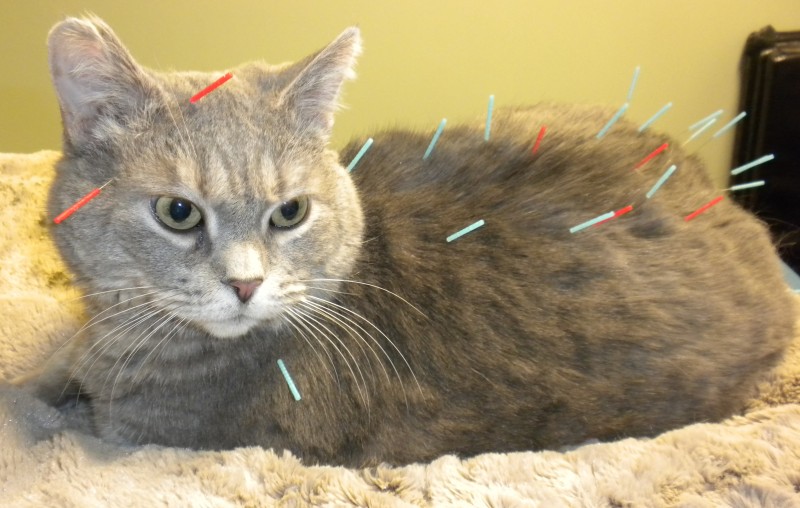Canine Osteoarthritis: Part II Identification & Treatment
By Lisa Blanchard BA, LVT, CMT, CCRP, FP-MT
Canine Osteoarthritis: Proper Identification and Effective Treatments
In our November blog, we discussed the importance of early diagnosis of Osteoarthritis (OA). We explained some of the clinical signs of OA that would be helpful in recognizing the disease as well as some of the treatment options available to manage the disease. In this installment, we look deeper into treatment options including the use of nutraceuticals, essential fatty acids, and Adequan.
A Multimodal Approach to Managing Osteoarthritis
The goals in OA management are to relieve pain, reduce inflammation, improve joint health, increase limb and core muscle strength, increase joint range of motion, improve quality of life and prevent future joint degeneration (5)(6).
Treating OA is best done by blending traditional and alternative therapies, thus creating a multimodal approach. When developing a plan for your pet the veterinarian selects therapies that work together to break the cycle of pain, joint stress, weight gain, reduced activity, and muscle atrophy to help restore your pet’s function and quality of life. The modalities of OA management work synergistically (like a rowing team) to ensure that the pet has less pain, better function, and improved quality of life.
Components of a Multimodal Approach to Managing Osteoarthritis
The main components of a multimodal OA management program are (discussed in November 2015 blog):
-
 NSAIDs (Non-Steroidal Anti-Inflammatory Drugs
NSAIDs (Non-Steroidal Anti-Inflammatory Drugs - Adjuncts (i.e. Tramadol, Gabapentin, etc.)
- Weight Control
- Rehabilitation
- Environmental Modification
Today we will discuss:
- Nutraceuticals (joint supplements)
- Essential Fatty Acids (ESA)
- Adequan ®
Nutraceuticals
This is a very broad category and includes many dietary supplements and herbal products. There are hundreds of “food additives” that classify as nutraceuticals. The most popular of which are glucosamine hydrochloride, chondroitin sulfate, and methylsulfonylmethane (MSM). Glucosamine HCL and chondroitin sulfate help to protect and heal the damaged joint cartilage (7), while the MSM acts as an anti-inflammatory. A newcomer in the nutraceutical arena is avocado/soybean unsaponifiables (ASU). Human studies have shown that ASU may improve cartilage repair and slow the effects of OA by decreasing cartilage degradation (1).
Unfortunately, nutraceuticals (human or animal) are classified as “food additives” and are not regulated by the FDA, so all products are not created equal (1). To ensure the least amount gastrointestinal side effects and best results it is better to stick with a joint supplement that is specifically formulated for pets. In addition, some herbal products can be contraindicated with certain prescription medications, which is why it is very important to always communicate to your veterinarian what supplements you are giving your pet.
Essential Fatty Acids (ESA)
Fish oil is the most common source of omega-3 fatty acids, and can be found in capsules and liquid form. Omega-3 fatty acids, specifically, eicosapentaenoic acid (EPA) and docosahexaenoic acid (DHA) are used to help manage many canine inflammatory diseases (3). EPA and DHA have anti-inflammatory properties and have therapeutic effects to the synovium and cartilage (4) which work together to provide friction-less movement and shock absorbtion in the joint.
As with nutraceuticals, there are many fish oil products on the market and it is difficult to get good quality product as they are not FDA regulated. For best results, select a product specifically formulated for pets.
Adequan ®
Adequan is an injectable polysulfated glycosaminoglycan (PSGAG) product that is FDA approved for use in horses and dogs (2). Simply put, Adequan increases the level of synovial fluid between the joints and helps to keep the articular cartilage healthy on the ends of the bones so they do not rub together.
Adequan is most effective when administered in the early stages of OA, and not just for geriatric dogs. Once cartilage is lost, it is gone forever! It is helpful for dogs that have undergone joint surgery as OA will begin to develop more quickly. Recent studies are showing that it is also beneficial to start puppies and young dogs with poor joints conformation on Adequan (i.e. such as those with hip dysplasia).
When To Begin Oral Supplements?
This has been a long-standing debate and is a discussion that you should have with your veterinarian. However, research conducted by Dr. Sherman O. Canapp from Veterinary Orthopedic Sports Medicine Group in Maryland has indicated that dogs given glucosamine and chondroitin before OA onset have less pain and inflammation compared to those dogs that received glucosamine and chondriotin after the onset of OA. The doctors at VOSM recommend specifically that performance dogs start on a glucosamine/chondriotin supplement as well as an omega-3 fatty acid when training begins in order to best protect their joints (4).
The Commitment to Managing Osteoarthritis
As a reminder, osteoarthritis is a disease requires a life long committment to management. Early diagnosis and treatment are key to the process. Providing good nutrition with proper oral joint supplementation can help not only with pain management, but also with prevention if you are dealing with a young pet or a performance animal. Injectable PSGAGs such as Adequan ® can help protect and repair the articular joint cartilage.
The goal is to get the patient stronger and manage their pain so that they are more functional and have a better quality of life. A strong team is needed to help the pet, which will include the owner, referring veterinarian, and veterinary rehabilitation professionals. A multimodal approach to OA management is the best way to ensure that your pet has the best quality of life.
Stay tuned next month where we will give you tips on weight management for your pet!
References:
- Fox S, Millis, D (2010), Multimodal Management of Canine Osteoarthritis, 48-49. Manson Publishing Ltd.
- Fox S, Millis, D (2010), Multimodal Management of Canine Osteoarthritis, 41. Manson Publishing Ltd.
- Goldberg ME, Shaffran N (2015), Pain Management for Veterinary Technicians and Nurses, pp. 139 Wiley-Blackwell
- Dycus D, Canapp D, “Oral Joint Supplements in Agility Dogs”, Clean Run, July 2015, pp. 51-55
- MacPhail C (2000). Treatment of Canine Osteoarthritis. WALTHAM Focus, Vol 10, No2, pp 25-30. Retrieved from Bearscamp Newfoundlands May 4, 2015. http://www.bearscampnewfs.com/health/Waltham%20Center/Treatment%20of%20Canine%20Osteoarthritis.pdf,
- Edge-Hughes L. Treatment of Osteoarthritis in the Literature. Retrieved from Four Leg Rehab, Inc. August 30, 2012. http://www.fourleg.com/
- Canapp S, “Joint Protective Agents for Performance Dogs”, Clean Run, May 2007., pp. 2-6
